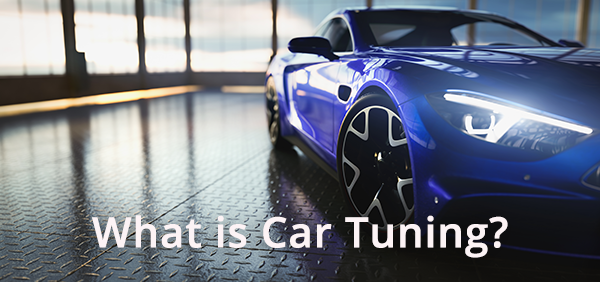Car tuning is recognised as being an improvement or adaptation of a vehicle with the purpose of making it perform in a way that the driver needs it to perform. Basically, it describes a vehicle being changed to make it better at performing a certain task. If it needs more traction, tyres can be changed, if it needs more power engine components can be replaced or changed to create more power. If an off-road vehicle requires more distance from the floor to the chassis and engine, it can be raised by adapting suspension with a lift kit.
Car tuning will be unique to the car but also what the driver wants from the car. The questions people ask when tuning cars is “what do I want to do in the vehicle?”, “What do I want the vehicle to do?” and “What can I change to make it better at what I want it to do? A list can be made of what needs to change and a plan put in place to carry it out the changes.
Car Tuning Guide For Beginnners
The areas of car tuning really are the same for beginners all the way through to highly experienced tuning specialists. It is often the synergy and choice of tuning that needs to be applied to a certain driver, in a certain vehicle, in a certain race/situation that the more advanced tuner will master. Saying that the main areas are so key we thought it was important to explain them further in the next section.
What Are The Basics Of Engine Tuning?
We will group the main areas that are considered when tuning and run through some of the functions of the components involved. This will help to explain the basics of engine tuning.
Air Intake

Forced Induction
Turbo Chargers and Superchargers
- Forced Induction refers to a turbo or supercharger that will be fitted to a car. They both force compressed air into the engine creating large amounts of power increase from the engine. The fuel is burnt within the engine chambers with oxygen from the air. If more air is forced in by a turbo or supercharger the engine can produce much more power.
- A turbocharger utilises the movement of exhaust gases. The flowing exhaust gas flows past the blades on the propellor withing the turbo. This propellor is joined by a shaft that rotates a compressor on the opposite side. This compressor as it is turned by the propellor forces compressed fresh air into the engine. This compressed air allows for more power output from the engine.
- The amount of compressed air entering the engine has to be controlled however as if the level becomes too high for an engine it could overstress and lead to serious damage. This is done by the use of a bypass valve. This is a valve that is opened when the compressor pressure reaches a certain level. When it reaches a certain level, it opens to release the exhaust gas diverting out of the turbo stopping the pressure going any higher. The boost valve is, in most modern cars, controlled by the software on the ECU.
- As supercharger still uses a compressor to force air into the engine but rather than using exhaust gases to power the compressor, like a turbo, it actually uses some of the engine power. Most commonly there will be a belt and pulley from the engine crankshaft which turns the compressor. As the crankshaft turns, the belt attached will turn the supercharger compressor and force air into the engine.
- A supercharger has the benefit of operating and increasing engine power at lower RPM due to the fact that as the crankshaft starts moving, so does the supercharger compressor. A turbo requires exhaust flow to build so there can often be a delay before the turbo kicks in.
- At higher rpm however superchargers can be less efficient that a turbo as the supercharger utilises some of the engine power to drive the compressor.
Intercoolers
- An intercooler is a component that cools the air that has been produced by the turbo. The air that leaves the turbo has been compressed by the internal compressor. This process is key, but it heats up the air. The warmer air is the lower density it becomes. Hot air works well in a hot air balloon where the lower density air, trapped in the balloon, lifts the basket but in an engine hot air will reduce power as the lower the density of the air (the warmer it is) the less oxygen there is to burn within it.
Charge Coolers
- Like Intercoolers, Charge Coolers sit after the turbo or supercharger and cool the air that has been compressed and is heading towards the engine for combustion. This makes the air denser meaning it carries more oxygen to the chamber and can increase power.
- The benefits of a charge cooler are that the warmer compressed air cooled down by water instead of air (like and intercooler does). Water can store a lot more heat energy than air and this means that the charge cooler can take away heat more efficiently and can be smaller than an intercooler. It also can increase low end power as the water can be cooler immediately on throttle being pressed where an intercooler needs airflow to build to allow the air movement to cool the air inside the intercooler.

Management of Fuelling
Fuelling of a vehicle refers to the delivery of the fuel to the chamber for it to be burnt. This burning of fuel happens under compression and needs air to provide oxygen to make and air/fuel mixture. The burning of fuel in this way happens within the chambers of the engine. Each time the piston rises up it compresses the fuel/air mixture within the chamber and a spark from the ignition source causes it to burn(combust). This drives the piston back down and alongside the other cylinders and pistons it rotates the crankshaft. This drives the car forward.
In modern cars the amount of fuel that is injected is controlled by the car’s ECU (Electronic Control Unit). This ECU is a computer that has software installed (known as a “map”). Depending on which map is installed it will monitor and control the amount of fuel that is injected into the chamber as the car performs.
A car’s ECU can be remapped to increase the amount of fuel injected into the chamber but its key to note that just adding more fuel doesn’t mean better performance. The ratio of air to fuel must be correct for optimal burning. If the fuel/air ratio mixture in incorrect it is like trying to light a fire with too little fuel and too much air or too much fuel and minimal air to burn. It just doesn’t combust well.
How to improve fuelling of a car
- When a car has an increase of air into the chamber the fuelling has to match to keep the ratios of air/fuel optimised. The ECU being remapped and often the use of a rolling road will allow the correct map selection to provide fuelling to the car as required throughout the engine range.
- An ECU remap is usually needed when something like a turbo or superchargers is upgraded or output by them is adjusted. As superchargers and turbochargers force air into the engine to be burnt (forced induction), the more air that is delivered to the engine by these components, the more fuel has to be delivered to match. An ECU remap will adjust the fuelling control to do just this.
- Fuel injection systems can also be changed or upgraded. This can be the injectors themselves, that direct and spray the fuel into the chamber, but also full systems that feedback to the ECU.
Ignition
As we mention above the fuel inside the cylinder requires air, fuel and a spark when it is compressed to burn. The mixture of fuel and air must be correct, but the spark needs to be strong enough to start the combustion process off and also timed correctly with the rest of the mixture. The timing of the spark happening is what you hear being described when you hear ignition timing being mentioned.
How to improve Ignition
- Having the correct Spark Plugs in place is key to match the temperatures inside the engine. Choosing the correct spark plugs will be determined by the engine set up as well as the make and model of the car. You can speak to your technician tuning your car to ensure you are running the correct spark plugs.
- The map software on the ECU is what controls the timing of the spark, so it is key that the correct map is on the ECU. The car’s ECU will usually need remapping to upgrade the engine performance and this will include the spark timing.

